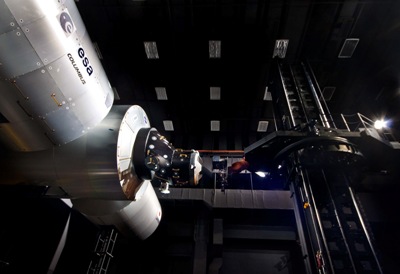The Space Operations Simulation Center (SOSC) of Lockheed Martin has successfully finished the first orbital simulation for Sensor Test for Orion Relative Navigation Risk Mitigation (STORRM) with data and hardware that was carried with the STS-134 space shuttle Endeavour mission of NASA to the International Space Station.
The test illustrated SOSC’s potential to reproduce an on-orbit environment that impacts motion control, lighting and relative navigation in space. During the STS-134 mission, the Endeavour team successfully examined the STORRM unit’s docking camera and vision navigation sensor (VNS) during docking and undocking activities in the International Space Station.
 An Orion vision navigation sensor mounted on a robotic arm docks with a full-scale space station docking port in SOSC
An Orion vision navigation sensor mounted on a robotic arm docks with a full-scale space station docking port in SOSC
The on-orbit test assessed the performance of a novel navigation sensor suite designed for Orion and other upcoming spacecrafts. STORRM illustrates a robust comparative navigation design that offers needed docking precision and functionality to fulfill crew volume, mass, safety and power needs for several upcoming NASA missions.
The STORRM test is the only chance for in-flight partnership of NASA’s three human spaceflight programs, the Orion Multi-Purpose Crew Vehicle, International Space Station and the Space Shuttle. For this demonstration, a complete range, highly reliable replicate of a space station docking port featuring reflective sensors acting as the target environment.
STORRM is an advanced technology development program headed by NASA’s Multi-Purpose Crew Vehicle Program Office at NASA Johnson Space Center in collaboration with Ball Aerospace & Technologies, Lockheed Martin Space Systems and NASA Langley Research Center. This technology finds applications in transportation, military operations, robotics, terrain mapping, such as collision avoidance systems for spacecrafts.
John Karas, who serves as Lockheed Martin Space Systems’ Vice President and General Manager of Human Space Flight, stated that the company will analyze the telemetry and data gathered in the laboratory with the on-orbit telemetry and data to standardize the SOSC to an actual space condition, further augmenting the reliability of this facility for upcoming simulations.